Want a flatter belly and a stronger body without complicated workouts? Exercises for mid section target your abs, obliques, and then lower back—your midsection, which is the powerhouse of your body.
Furthermore, a strong core doesn’t just help you look better; it supports better posture, improves balance, prevents injuries, and even revs up your metabolism.
These easy exercises for the midsection are designed to help you build strength, burn fat, and feel your best—no gym required.
Medical Disclaimer: The information in this blog is for enlightening and educational purposes only and is not intended as medical advice. The content in this post is not meant to substitute for a professional medical diagnosis, advice, or treatment. Always ask advice from your physician or other qualified health providers with any questions you may have regarding a medical condition.
1. 90-90 Position
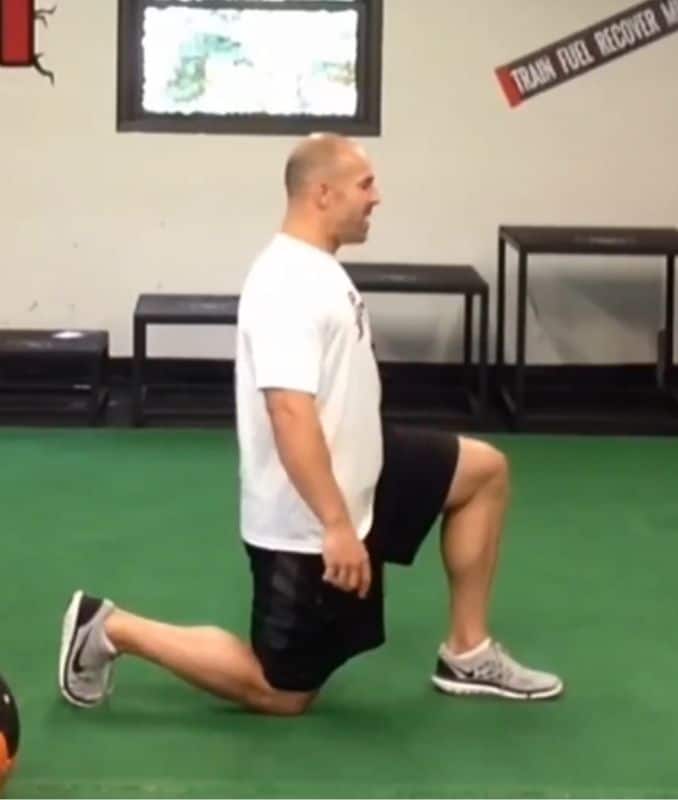
- First, begin in a 90-90 position.
- Place one knee on the floor.
- Form a 90-degree angle with the back leg, so your knee is directly under your hip.
- After that, make another 90-degree angle from the front leg.
- The ankle is located directly under the knee.
- Squeeze your glutes, stay tall, push the top of your head toward the ceiling, and then breathe into your belly during exercises for mid section.
Doing this will make you feel a phenomenal stretch in front of your hip.
It helps with balancing your pelvis and works your core at the same time. We can do multiple exercises from the 90-90 position, which is why it is so valuable.
I will bring this move in a line and show a chop or lift, depending on what angle you are coming from. It is with diagonal movements. Perform two or three sets of the following exercises to target your midsection with 8 to 12 repetitions on each side.
2. 90-90 Inline Position
- Start with the 90-90 position, keeping a normal stance like train tracks.
- Your front leg is on the line with the left side train track, and your right leg is on the line with the right track.
- You can feel some action from your hip, knee, and then ankle on both sides.
Let’s close that space by putting your front foot in line with your back knee as if you stepped out onto a tightrope. Make sure to keep your core tight [2] to avoid falling to your sides. This enables your core to work tremendously hard to keep you centered.
With the first level of this exercise, work on your diagrammatic breathing and stay nice and tall.
Hold this position with your core. It may be quite challenging, but don’t be afraid—Master the level 1 position.
3. 90-90 Inline Chop
- Basically, ball up your fists.
- Reach for the bottom of your hip and come across your body diagonally.
- Reach for the corner of the ceiling, come back toward the bottom hip, and then repeat the movements.
- You breathe in as you come down during exercises for mid section, and breathe out toward the ceiling.
Keep the movements on top of the stable midsection when working on these. Keep your stomach tight as you move your shoulders, ensuring everything below stays in place. You are moving on top of that stable base.
4. Medicine Ball Chop
- Grab a medicine ball.
- Reach for the bottom of your hip, keeping a tight midsection.
- Breathe in as you move the ball diagonally across your body.
- Exhale as the ball is extended toward the ceiling.
If you want to add another level of difficulty to this exercise [1], you can set up a cable crossover machine next to you. Grab a low-hand cable attachment and work across your body in the same diagonal fashion as the previous exercises to target your midsection.
Feel free to adjust the weight until it’s appropriate for exercises for mid section.
5. Pelvic Tilt (Supine)
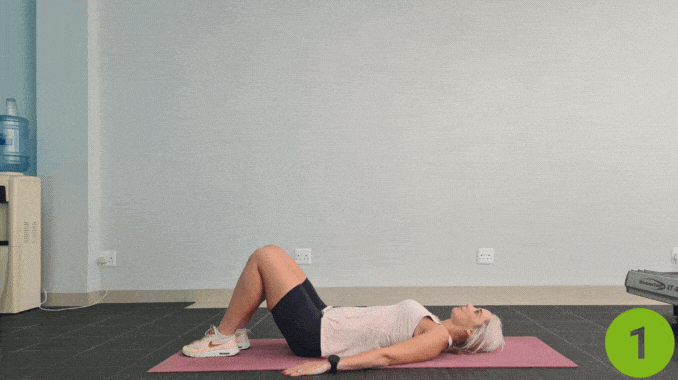
- Lie on your back with your knees bent and feet flat on the floor.
- Ensure your lower back is gently pressed against the floor to avoid strain.
- After that, slowly roll your pelvis backward as if you were flattening out your spine.
- Hold this position for several deep belly breaths, in through your nose and then out through your mouth.
- Slowly return to the starting position.
6. Dead Bug

- Lie on your back with your knees bent and then feet flat on the floor.
- Hold a dumbbell in each hand and extend your arms toward the ceiling.
- Engage your core and raise your legs to tabletop position.
- Slowly lower your right arm and left leg toward the floor.
- After that, return to the starting position and repeat on the opposite side.
- Perform the movement in a slow, controlled manner.
- Hold the position for several deep belly breaths, in through your nose and out through your mouth.
- Relax and then return to the starting position.
- Repeat the movement.
7. Heel Taps

- Begin in an upright sitting position on the edge of a chair, with your hands resting at your sides for support.
- Engage your core.
- Ensure your spine is straight and your core is engaged throughout the exercise.
- Lift one leg and tap your heel forward on the floor as part of exercises for mid section, then return to the starting position.
- Repeat the movement with the opposite leg.
- Continue alternating sides.
- Hold the position for several deep belly breaths, in through your nose and out through your mouth.
8. Seated Knee Tucks
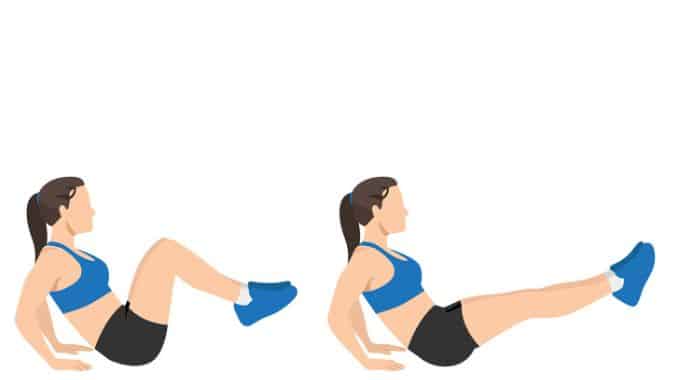
- Begin in a seated position on the floor with your hands placed slightly behind your hips for support.
- Lean back slightly and lift your feet off the floor, keeping your knees bent.
- Engage your core.
- Extend your legs straight out while keeping them elevated, then tuck your knees back in toward your chest.
- Repeat the movement in a slow and controlled manner.
- Hold the position for several deep belly breaths, in through your nose and out through your mouth.
9. Bird Dog
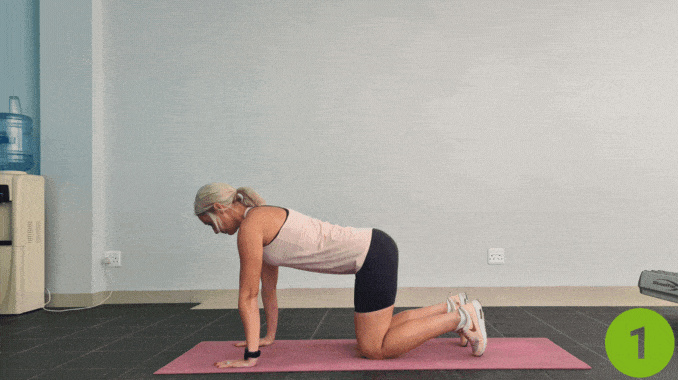
- Begin in a 4-point position with your hands beneath your shoulders and then your knees under your hips.
- After that, engage your core.
- Extend your right arm forward and your left leg back, maintaining good alignment with your head, shoulders, hips, and then legs.
- Keep your hips and shoulders square to the floor.
- Hold this position for several deep belly breaths, in through your nose and then out through your mouth.
- Slowly return to the starting position.
- Moreover, repeat the movement on the opposite side.
10. Glute Bridge

- Lie on your back on the floor with your knees bent and then feet flat on the floor.
- After that, raise both hands towards the ceiling.
- Contract your core and then press through your heels to lift your hips towards the ceiling, forming a straight line from your knees to your shoulders.
- Hold the position briefly, then slowly lower your hips back to the starting position.
11. Toe Reaches
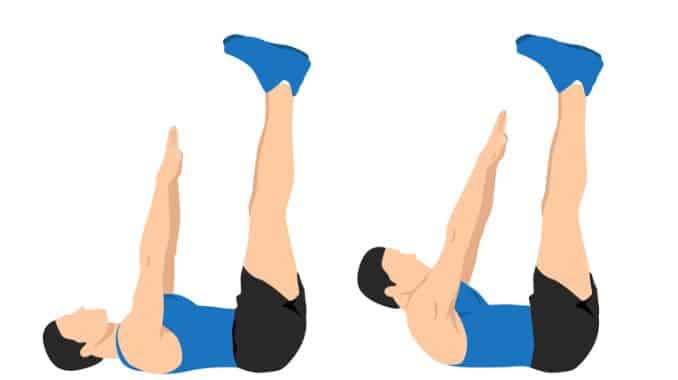
- Lie on your back with your legs extended straight up toward the ceiling, keeping them as straight as possible.
- After that, extend your arms toward your toes.
- Engage your core and then lift your shoulders off the floor as you reach your fingertips toward your toes.
- Hold this position for several deep belly breaths, in through your nose and out through your mouth, as part of your exercises for mid section.
- Slowly lower back down and then repeat the movement.
12. Seated Twists

- Begin in an upright sitting position, maintaining good alignment with your head, shoulders, and then hips.
- Place your left hand on your right knee and your right hand on the floor behind you.
- After that, contract your core, then look back and twist your upper body to one side.
- Hold the position for 10 seconds.
- Return to the starting position and then repeat the movement on the opposite side.
13. Mountain Climber

- Move into a four-point position, with your knees below your hips and then your hands beneath your shoulders.
- After that, tighten your core.
- Move into a full plank position, maintaining proper alignment with your head, shoulders, hips, and then toes.
- Bring your left knee towards your chest and then switch legs in a running motion while maintaining the plank position.
- Return to the starting position and then repeat the movement.
Exploring the Midsection
The core includes your abs, obliques, and lower back muscles, working together to support movement, posture, and then stability.
- Rectus Abdominis [3]: a pair of long, flat muscles that run vertically along the front of the abdomen. The “six-pack” muscle that flexes the spine—key for bending forward.
- Obliques: Side muscles that assist with twisting, side bending, and then core stability.
- Transverse Abdominis: Deep core muscle that acts like a corset to stabilize your spine and pelvis.
- Erector Spinae: Back muscles that extend the spine and then support posture during bending or lifting.
Why Strengthen the Midsection?

The abdominal area [4] is crucial for:
- Holding internal organs (viscera) in place
- Maintaining posture
- Controlling diaphragm function
- Stabilizing the body
- Preventing inguinal hernia
- Reducing the abdominal cavity volume through exercises for mid section, especially useful for aviators to prevent blackout caused by venous pooling in the splanchnic region.
A strong abdominal wall [5] is essential for:
- Holding viscera in place
- Supporting posture
- Facilitating diaphragm control
- Enhancing full-body control
- Helping prevent groin hernias and reducing pressure inside the belly, which is especially important for pilots to avoid blood flow issues and fainting during flight.
According to Dr. Mandell emphasizes that proper form beats intensity every time. The real results come from slow, controlled movements—especially when you exhale and pull your belly button in toward your spine. That’s the key to fully activating your deep core muscles.
Conclusion
You don’t need endless crunches or fancy gym equipment to get results.
These 13 simple midsection moves are great exercises that target the key body forms—like your deep abdominal muscles and obliques—that shape your waistline, support your spine, and fire up your fat-burning engine.
Furthermore, each exercise strengthens your core and helps you lose those few inches around your midsection.
Whether you’re just starting or getting back on track, a few minutes of resistance training and focused movement each day can lead to real change.
Stay consistent with exercises for mid section—a stronger, leaner core is within reach, one rep at a time.
Take control of your fitness with Invincible Core—the ultimate digital guide to core strength and stability. Whether you’re at home or on the go, these expertly designed workouts will challenge and transform your body.
FAQs
How to strengthen your midsection?
To strengthen your midsection, focus on core exercises that work your entire core—not just the front of your belly. Great options include plank position holds, mountain climbers, and then lower ab workouts like leg raises or toe taps. These moves activate your deep abdominal muscles, internal and external obliques, and help build real core strength. For best results, keep your core tight, maintain a neutral position (back flat, no arch), and do both ab exercises and weight training for your entire body.
What is the best exercise for the midriff bulge?
The most effective move to reduce midriff bulge is the plank position—simple, but powerful. It targets your deep abdominal muscles, internal and external obliques, and engages your entire core, including stabilizer muscles. Additionally, combine that with mountain climbers in a fully extended position (hands under shoulders, legs straight) to add a fat-burning boost.
How do I tone my midsection?
To tone your midsection, aim for a mix of lower ab exercises, core exercises, and ab workouts that challenge your deep abdominal muscles. Always keep your core tight, breathe deeply, and include exercises that lift your shoulder blades off the floor, like crunches or toe reaches. Moreover, don’t forget to work your entire body too, using weight training to burn more calories overall.
What is the most effective abdominal exercise?
The most effective ab exercise is the plank. It engages your entire core, including the deep abdominal muscles, obliques, and even your back and legs. For even better results, add movement, like mountain climbers or tapping your right knee to the opposite elbow while staying in the plank position.


